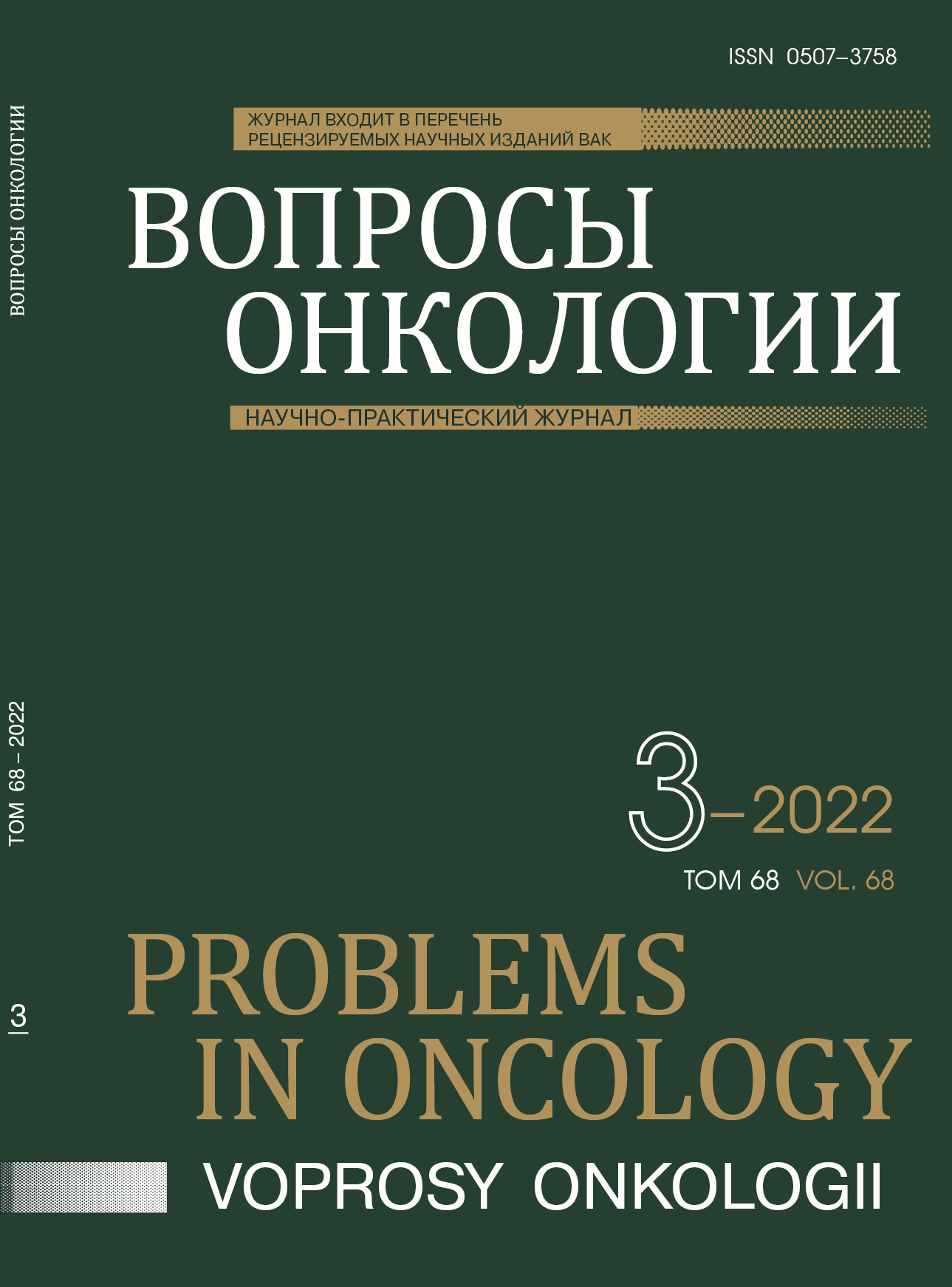Abstract
Active screening for early detection of breast cancer and new treatment options have significantly reduced mortality from breast cancer. However, a significant number of patients with non-metastatic breast cancer have advanced disease at the time of diagnosis. Triple negative breast cancer (TNBC) is a specific cancer subtype characterized with deep invasiveness, high metastatic potential, tendency to recurrence, and poor prognosis. It is known to have no application to endocrine therapy or anti-HER2 therapy. The search for new markers is an important direction in predicting the course of the disease and the effectiveness of treatment, monitoring progression and relapse. This study presents an analysis of blood levels of factors of growth and progression (TGFβ, TGFR2, TNFα. TNFαR1, TNFαR2, CD-44 and MMP-9) and circulating tumor cells (CTCs) in 56 patients with locally advancer TNBC after complex treatment. We identified a complex of growth and progression factors that determines the sensitivity and resistance to chemotherapy in all BC subtypes. Decreased levels of TGF-β, TNFα, MMP-9, CD-44 and CTCs after neoadjuvant chemotherapy determine further remission during 3 years. On the contrary, stabilization or elevation of these parameters leads to an early tumor progression
References
Siegel RL, Miller KD, Jemal A. Cancer statistics, 2018 // CA Cancer J Clin. 2018;68(1):7–30. doi:10.3322/caac.21442
Bray F, Ferlay J, Soerjomataram I et al. Global cancer statistics 2018: GLOBOCAN estimates of incidence and mortality worldwide for 36 cancers in 185 countries // CA Cancer J Clin. 2018;68(6):394–424. doi:10.3322/caac.21492
Bianchini G, Balko JM, Mayer IA et al. Triple-negative breast cancer: challenges and opportunities of a heterogeneous disease // Nat Rev Clin Oncol. 2016;13(11):674–690. doi:10.1038/nrclinonc.2016.66
O'Conor CJ, Chen T, González I et al. Cancer stem cells in triple-negative breast cancer: a potential target and prognostic marker // Biomark Med. 2018;12(7):813–820. doi:10.2217/bmm-2017-0398
Huang H. Matrix Metalloproteinase-9 (MMP-9) as a Cancer Biomarker and MMP-9 Biosensors: Recent Advances // Sensors (Basel). 2018;18(10):32–49. doi:10.3390/s18103249
Munzone E, Botteri E, Sandri MT et al. Prognostic value of circulating tumor cells according to immunohistochemically defined molecular subtypes in advanced breast cancer // Clin Breast Cancer. 2012;12(5):340–6. doi:10.1016/j.clbc.2012.07.001
Paoletti C, Hayes DF. Circulating Tumor Cells // Adv Exp Med Biol. 2016;882:235–58. doi:10.1007/978-3-319-22909-6_10
Papageorgis P, Stylianopoulos T. Role of TGFβ in regulation of the tumor microenvironment and drug delivery (review) // Int J Oncol. 2015;46(3):933–43. doi:10.3892/ijo.2015.2816
Liang S, Chang L. Serum matrix metalloproteinase-9 level as a biomarker for colorectal cancer: a diagnostic meta-analysis // Biomark Med. 2018;12(4):393–402. doi:10.2217/bmm-2017-0206
Кит О.И., Шатова Ю.С., Новикова И.А. и др. Экспрессия Р53 И BCL2 при различных подтипах рака молочной железы // Фундаментальные исследования. 2014;10(1): 85–88. doi:fundamental-research.ru/ru/article/view?id=35219 [Kit OI, Shatova YS, Novikova IA et.al. Ekspressiy P53 I BCL2 pri razlichnih podtipah raka molochnoy zhelezi // Fundamentalnye issledovaniya. 2014;10(1): 85–88 (In Russ.)]. doi:fundamental-research.ru/ru/article/view?id=35219
Кит О.И., Шатова Ю.С., Франциянц Е.М. и др. Путь к персонифицированной тактике лечения больных раком молочной железы // Вопросы онкологии. 2017;63(5):719–723. doi:10.37469/0507-3758-2017-63-5-719-723 [Kit OI, Shatova YS, Franciync EM et al. Put k personifecirovannoy taktike lechenia bolnih rakom molochnoy zhelezi // Voprosy onkologii. 2017;63(5):719–723 (In Russ.)]. doi:10.37469/0507-3758-2017-63-5-719-723
Chiappini F. Circulating tumor cells measurements in hepatocellular carcinoma // Int J Hepatol. 2012;2012:684–802. doi:10.1155/2012/684802
Nadal R, Lorente JA, Rosell R, Serrano MJ. Relevance of molecular characterization of circulating tumor cells in breast cancer in the era of targeted therapies // Expert Rev Mol Diagn. 2013;13(3):295–307. doi:10.1586/erm.13.7

This work is licensed under a Creative Commons Attribution-NonCommercial-NoDerivatives 4.0 International License.
© АННМО «Вопросы онкологии», Copyright (c) 2022
